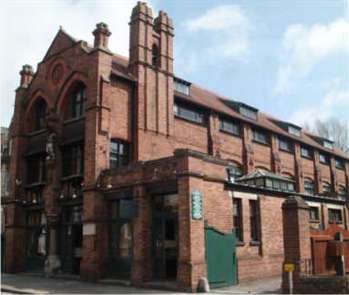
JOHN ANGEL F.R.B.S |
John Angel was born in the December Quarter of 1881 in Newton Abbot, Devon. He was the son of Samuel and Anna Angel and his father was a tailor.
Birthplaces for their children as shown in the 1891 Census reveal a family which moved around fairly frequently - their eldest son, Samuel had been born in the Paddington area of London - but by that year they had settled down in Regent Street in St. Thomas, not, at that time, part of the City of Exeter. His son Samuel and daughter Florence had already joined their father in his trade. |
The 1901 Census reveals that his son John's career took off in quite a different direction - then aged 19, he was apprenticed to a wood carver. At this time, there were two possible places where this could have happened - either at the workshops of the great wood and stone carver Harry Hems in Longbrook Street, Exeter or very close to Regent Street, in the workshops of the renowned ecclesiastical suppliers, Whippell Brothers. Like John Angel, Harry Hems made a name for himself in the United States notably for his work on, and in, Christ Church Cathedral, St. Louis City. |
 |
The studios of Harry Hems in Longbrook St., Exeter |
 |
Exeter had an excellent School of Art and John Angel received his early training there before attending the Lambeth School of Art and the Academy School were he studied with Sir George Frampton R. A. Sir George was an eminent sculptor, famous for his symbolic figures - many will be familiar with his statue of Nurse Edith Cavell in St. Martin's Place, London. He was to become a great influence on John Angel as we see in one of Angel's first important public pieces, Exeter's Northernhay War Memorial. |
Exeter War Memorial in Northernhay Gardens Commissioned in 1921 - completed in 1923 |
Unlike Harry Hems, John Angel did not return to Exeter but made his home in London. He married an American, Elizabeth Day Seymour and in 1915, their first child - John Lawrence Angel - was born on March 21st to be followed by Henry Seymour Angel who was born in 1919. In April 1923, Elizabeth took her two sons to the USA for the first time, on a 4-month visit to her brother, Professor Charles Seymour of New Haven. In 1919, before he was 30 years old, John Angel was elected a Fellow of the Royal Society of British Sculptors and from that time, began to receive a number of important commissions - a year after the completion of the Exeter War Memorial, another striking Memorial was unveiled at Bridgewater in Somerset. However, soon after this, John began to realise that his future lay, not in the United Kingdom, but in the United States of America and in 1928, the family emigrated. By the time of his death on 16 Oct 1960 in Connecticut, John Angel had established himself as one of the foremost sculptors in America. His numerous commissions included figures for the cathedral of St John the Divine in New York and this striking figure of Francis Vigo for the George Rogers Clark Memorial Park in Vincennes. Weighing over ten tons, the piece was crafted in New York and taken by rail to its final position overlooking the Wabash River where its positioning was personally supervised by the sculptor. It was this work of which John Angel said: "It is probably the best piece of work I have done". |
 |
"Francis Vigo" (Vincennes) by John Angel |
© M.E. Brine. This page last updated
31 July, 2009
|